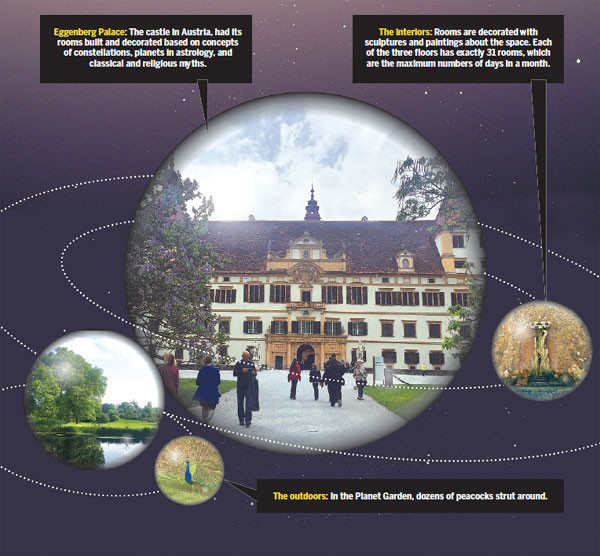Exploring a palatial universe
By Wang Shanshanwang ( China Daily ) Updated: 2015-07-11 08:15:44
 |
|
China Daily Photo Illustration from Photos by Wang Shanshan. |
An Austrian palace's architecture and design revolve around references to the science and legend of outer space.
When I was a little girl, my father, a scientist, said that I should grow up and work for the National Aeronautics and Space Administration (NASA) of the United States, which he deeply loves as a cool scientific institution.
His wish never came true, but my favorite movies are the Star Wars series, my favorite robot R2D2, and I can even speak a little of the fictional language, Galactic Basic.
But none of the space fanatics I know would ever be so rich as to own a whole constructed universe - a palace of stars and galaxies, as Hans Ulrich von Eggenberg of Austria did five centuries ago.
Eggenberg Palace, or Schloss Eggenberg in German, in Graz in Austria, had its rooms built and decorated based on concepts of constellations, planets in astrology, classical and religious myths. It has a Planet Garden, where dozens of peacocks strut around.
A combination of Goethe, Renaissance and Baroque architectures, the palace lies on the western edge of Graz, the second largest city in Austria that is a four hours' train ride south of Vienna. Both the Old City of Graz and the mythical palace are UNESCO World Heritage Sites.
The whole three-floor palace is decorated with paintings about space. The 600 ceiling paintings, for example, tell stories of the universe, about the movements of planets, people's understanding of the sun and other stars, and the legends about them from Greek and Roman mythology.
The Planetary Room, the main hall, on the top floor is the center of this "universe". It has giant paintings covering all the walls and the ceiling, depicting stories about the origins of the 12 astrological signs - Aries, Taurus, Gemini, etc.
|
|
|
|
|
|
|
|

























 Raymond Zhou:
Raymond Zhou: Pauline D Loh:
Pauline D Loh: Hot Pot
Hot Pot Eco China
Eco China China Dream
China Dream China Face
China Face






